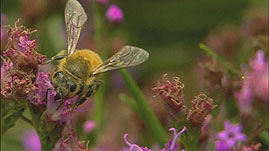Teachers' Domain - Digital Media for the Classroom and Professional Development
User: Preview

Source: QUEST:Better Bee and Super Bee


Bees help with pollination of the flowers that lead to the growth of delicious fruits, vegetables, and nuts that we see at our markets. Currently, our native honeybee population is in danger. I this video segment, adapted from QUEST, you'll learn about the work of pollination and our dire need to ensure that we have a strong population of honeybees.
Many of us do not consider honeybees as anything other than another, potentially annoying, insect. However, these buzzing beauties are an integral part of our recommended daily diets. Without honeybees, we would not be able to enjoy the many fruits, vegetables, and nuts that adorn our refrigerators and markets. The pollination that bees facilitate is a critical factor in producing well-formed produce. Take fruit for example: The basic purpose of a fruit is not just to provide living things with food, but is to help facilitate reproduction via seeds which are encased and protected within it.
Honeybees (Apis mellifera) are extremely valuable to farmers for pretty obvious reasons. An entire global industry has been established based on the transportation, distribution and maintenance of large populations of the insects. Beekeepers are paid to travel to different farms to help farmers pollinate their crops. These specially trained experts charge fees to farmers for allowing their bees to pollinate their crops.
As honeybees move from flower to flower, collecting nectar for their honey reserves, tiny pollen grains stick to their legs and bodies. When they move onto the next bloom, some of the bits of pollen are left behind. These pollen grains fertilize the ovules that are hidden below the flower’s exterior. These fertilized ovules eventually develop into seeds. Flowering fruits will have flowers that attract bees to them with their sweet nectar, so that the bees will leave behind their pollen deposits. In this way, plant and insect work in tandem to create the seed-laden fruits that contribute to our well-balanced diets.
 Loading Standards
Loading Standards